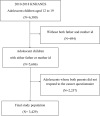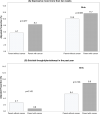Health behaviors and psychological burden of adolescents after parental cancer diagnosis
- PMID: 36471102
- PMCID: PMC9722667
- DOI: 10.1038/s41598-022-25256-5
Health behaviors and psychological burden of adolescents after parental cancer diagnosis
Abstract
This study aims to investigate health behaviors and psychological burdens in adolescent children of cancer parents. We compared health behaviors and mental health outcomes between 266 adolescent children with a parent diagnosed with cancer and 3163 control adolescents aged 12-19 years using data from the Korean National Health and Nutrition Examination Survey (KNHANES) from 2010 to 2018. Alcohol use of adolescents increased between 2 and 5 years after parental cancer diagnosis (adjusted odds ratio [aOR], 1.72; 95% confidence interval [CI], 1.01-2.94) but decreased after 5 years. Parental cancer was associated with increased vaccination uptake in adolescents within 1 year of diagnosis (aOR, 3.19; 95% CI, 1.55-6.54), but after 2 years, there was no difference from rates in their peers. Maternal cancer was associated with increased depression among adolescents (aOR, 1.73; 95% CI, 1.10 - 2.73). Although the risks of suicidal thoughts/plans/attempts increased within 1 year after parental cancer diagnosis (aOR, 2.96; 95% CI, 1.00 - 8.83), it reduced 2 years after diagnosis, leading to no significant difference from the frequency in peers. Within five years after the parent was diagnosed with cancer, support for their adolescent children's health behaviors and mental health is necessary in the community.
© 2022. The Author(s).
Conflict of interest statement
The authors declare no competing interests.
Figures
Similar articles
-
Association of parental depression with adolescent children's psychological well-being and health behaviors.BMC Public Health. 2024 May 27;24(1):1412. doi: 10.1186/s12889-024-18337-9. BMC Public Health. 2024. PMID: 38802817 Free PMC article.
-
Influence of parental stress, depressed mood, and suicidal ideation on adolescents' suicidal ideation : The 2008-2013 Korean National Health and Nutrition Examination Survey.J Affect Disord. 2019 Mar 1;246:571-577. doi: 10.1016/j.jad.2018.12.097. Epub 2018 Dec 25. J Affect Disord. 2019. PMID: 30605875
-
Suicidal ideation from parents to their children: An association between parent's suicidal ideation and their children's suicidal ideation in South Korea.Compr Psychiatry. 2020 Aug;101:152181. doi: 10.1016/j.comppsych.2020.152181. Epub 2020 May 4. Compr Psychiatry. 2020. PMID: 32473384
-
Relationships among cyberbullying, parental attitudes, self-harm and suicidal behavior among adolescents: results from a school-based survey in Vietnam.BMC Public Health. 2020 Apr 10;20(1):476. doi: 10.1186/s12889-020-08500-3. BMC Public Health. 2020. PMID: 32276608 Free PMC article.
-
Homicidal/violent thoughts, suicidal ideation and violent behavior in adolescents with social phobia in Metropolitan Lima, Perú.Asia Pac Psychiatry. 2014 Sep;6(3):252-8. doi: 10.1111/appy.12129. Epub 2014 Apr 28. Asia Pac Psychiatry. 2014. PMID: 24771716 Review.
Cited by
-
Adverse health outcomes in offspring of parents with alcohol-related liver disease: Nationwide Danish cohort study.PLoS Med. 2024 Oct 23;21(10):e1004483. doi: 10.1371/journal.pmed.1004483. eCollection 2024 Oct. PLoS Med. 2024. PMID: 39441845 Free PMC article.
-
Comparison of clinical characteristics and pathologic complete response rate after neoadjuvant chemotherapy in women under 35 years and older women with breast cancer.Gland Surg. 2024 Nov 30;13(11):1907-1920. doi: 10.21037/gs-24-293. Epub 2024 Nov 24. Gland Surg. 2024. PMID: 39678411 Free PMC article.
-
Cancer and the family: Variations by sex and race/ethnicity.Cancer Med. 2024 Jan;13(2):e6969. doi: 10.1002/cam4.6969. Cancer Med. 2024. PMID: 38379329 Free PMC article.
-
Association of parental depression with adolescent children's psychological well-being and health behaviors.BMC Public Health. 2024 May 27;24(1):1412. doi: 10.1186/s12889-024-18337-9. BMC Public Health. 2024. PMID: 38802817 Free PMC article.
References
-
- Korea Central Cancer Registry, National. Cancer. Center, Annual report of cancer statistics in Korea in 2018, 60–61 (2020).
MeSH terms
LinkOut - more resources
Full Text Sources
Medical



